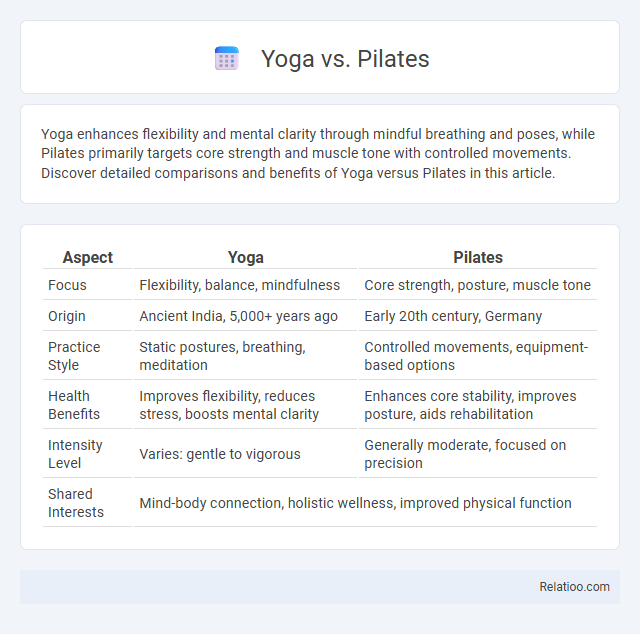Yoga enhances flexibility and mental clarity through mindful breathing and poses, while Pilates primarily targets core strength and muscle tone with controlled movements. Discover detailed comparisons and benefits of Yoga versus Pilates in this article.
Table of Comparison
| Aspect | Yoga | Pilates |
|---|---|---|
| Focus | Flexibility, balance, mindfulness | Core strength, posture, muscle tone |
| Origin | Ancient India, 5,000+ years ago | Early 20th century, Germany |
| Practice Style | Static postures, breathing, meditation | Controlled movements, equipment-based options |
| Health Benefits | Improves flexibility, reduces stress, boosts mental clarity | Enhances core stability, improves posture, aids rehabilitation |
| Intensity Level | Varies: gentle to vigorous | Generally moderate, focused on precision |
| Shared Interests | Mind-body connection, holistic wellness, improved physical function | |
Understanding the Basics: What is Yoga?
Yoga is an ancient practice originating from India that combines physical postures, breathing exercises, and meditation to promote holistic health and mental well-being. It emphasizes flexibility, balance, and mindfulness, integrating mind-body connection through controlled movements and relaxation techniques. Unlike Pilates, which primarily targets core strength and muscular endurance, yoga adopts a broader approach incorporating spiritual elements and stress reduction.
Breaking Down Pilates: Key Principles and Practices
Pilates emphasizes core strength, controlled movements, and breathing techniques to improve posture and flexibility, setting it apart from general physical activity and yoga. Your practice revolves around precise, low-impact exercises that enhance muscle endurance and mind-body connection without high-impact strain. Understanding Pilates' focus on alignment, concentration, and balanced muscle development can help you achieve improved strength and coordination efficiently.
Yoga vs Pilates: Core Philosophies Compared
Yoga emphasizes holistic mind-body balance through postures, breath control, and meditation, fostering spiritual growth and inner peace. Pilates concentrates on strengthening core muscles, improving posture, and enhancing physical alignment with precise, controlled movements. Your choice between the two depends on whether you prioritize mental tranquility and flexibility (Yoga) or targeted core strength and functional fitness (Pilates).
Physical Benefits: Flexibility, Strength, and Balance
Yoga enhances flexibility through poses that stretch muscles and improve joint mobility, while promoting strength by engaging stabilizing muscles during poses such as plank and downward dog. Pilates focuses on core strength and muscular endurance by targeting deep abdominal muscles, which improves posture and balance essential for functional movement. Regular physical activity broadly supports cardiovascular health, muscle tone, and coordination, contributing to overall flexibility, strength, and balance improvements.
Mind-Body Connection: Mindfulness in Yoga and Pilates
Yoga and Pilates both emphasize the mind-body connection through focused breathing and controlled movements, enhancing mindfulness and body awareness. Yoga incorporates meditation and spiritual elements, fostering mental clarity and relaxation, while Pilates centers on core strength and precise alignment, promoting concentration and physical control. Regular practice of either improves proprioception, reduces stress, and supports overall mental well-being.
Yoga and Pilates for Weight Loss: Which is More Effective?
Yoga and Pilates both aid weight loss by improving muscle tone and boosting metabolism, but Pilates often results in faster calorie burn due to its high-intensity core strengthening and resistance exercises. Yoga enhances flexibility, reduces stress, and promotes mindfulness, which can support long-term weight management through better eating habits. While Pilates focuses more on sculpting lean muscles to increase lean body mass, Yoga's holistic approach offers significant benefits for weight loss combined with mental wellness.
Injury Prevention and Rehabilitation: Pros and Cons
Yoga enhances flexibility and balance, reducing injury risk through mindful movement and breath control, but may exacerbate joint issues if poses are performed incorrectly. Pilates strengthens core muscles and improves posture, aiding rehabilitation from back and sports injuries, yet requires proper guidance to avoid strain from improper form. General physical activity promotes overall cardiovascular health and muscle endurance, which supports injury prevention, though high-impact exercises can increase the likelihood of acute injuries without adequate warm-up or technique.
Equipment and Practice Environments: What’s Needed?
Yoga requires minimal equipment, often just a yoga mat, and can be practiced in quiet, spacious environments like studios, gyms, or at home. Pilates typically involves specialized apparatus such as reformers, resistance bands, and stability balls, necessitating dedicated studio spaces or gyms with proper equipment. General physical activities vary widely but usually demand versatile and adaptable gear, making them suitable for diverse settings including outdoors, gyms, or sports centers.
Choosing the Right Practice: Factors to Consider
Choosing the right practice depends on your fitness goals, flexibility, and body awareness, with yoga emphasizing mindfulness and flexibility, Pilates focusing on core strength and posture, and general physical activity promoting overall cardiovascular health. Your individual needs, such as injury prevention or stress reduction, should guide the decision to ensure a sustainable and effective routine. Considering instructor expertise, class intensity, and personal preferences enhances the likelihood of long-term commitment and benefits.
Conclusion: Finding the Best Fit for Your Lifestyle
Choosing between yoga, Pilates, and other physical activities depends on your personal goals, whether improving flexibility, building core strength, or enhancing cardiovascular health. Yoga offers mindfulness and flexibility benefits, Pilates targets core muscles and posture, while various activities provide diverse fitness and social engagement opportunities. Assess your lifestyle needs and preferences to select the practice that best supports your well-being and long-term commitment.

Infographic: Yoga vs Pilates
 relatioo.com
relatioo.com